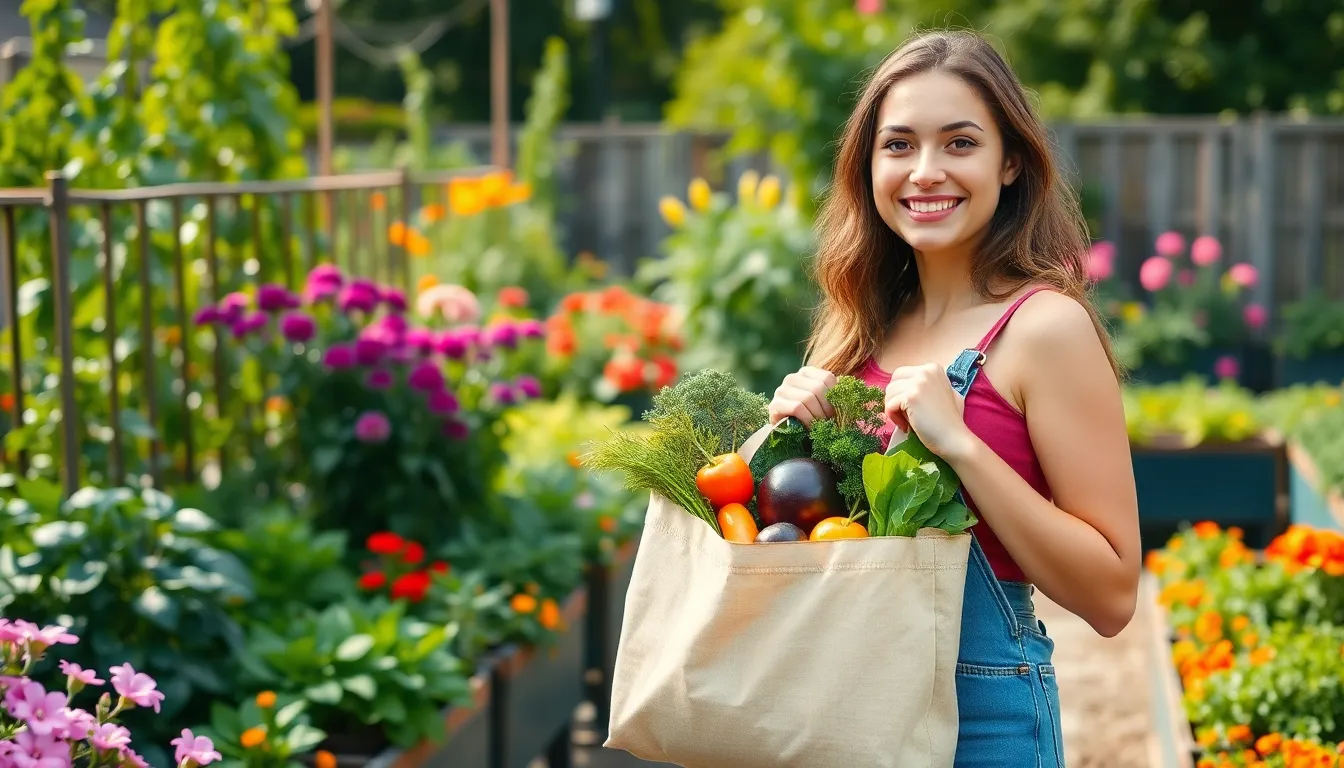In a world where plastic bags are more common than reusable ones and coffee cups have a shorter lifespan than a fruit fly, sustainable living feels like a noble quest. But fear not! Embracing eco-friendly habits doesn’t mean giving up your favorite things or living like a hermit in the woods. With a few simple tweaks, anyone can become a sustainability superhero, cape not required.
Table of Contents
ToggleUnderstanding Sustainable Living
Sustainable living encompasses practices and choices that minimize an individual’s or society’s environmental impact. This lifestyle promotes ecological balance while addressing the needs of present and future generations.
Definition of Sustainable Living
Sustainable living involves adopting habits that reduce resource consumption and waste creation. It emphasizes the use of renewable resources, recycling, and reducing carbon footprints. Individuals make choices such as using reusable bags, conserving energy, and choosing local foods. The goal centers on fostering an environment that supports biodiversity and healthy ecosystems.
Importance of Sustainability
Sustainability plays a crucial role in preserving natural resources for future generations. It addresses critical issues such as climate change, environmental degradation, and resource depletion. Promoting sustainability enhances quality of life while reducing health risks associated with pollution. Communities benefit from cleaner air and water and improved biodiversity. Prioritizing these changes ensures a healthier planet, fostering a sustainable future for all individuals and ecosystems.
Best Tips for Sustainable Living

Adopting sustainable practices creates positive change and contributes to a healthier planet. Here are essential tips for integrating sustainability into daily life.
Reduce, Reuse, and Recycle
Reducing waste starts with minimizing single-use items. Opt for products with minimal packaging and commit to using reusable bags, bottles, and containers. Reusing items creatively extends their lifespan. Donate or repurpose old furniture, clothing, or electronics instead of discarding them. Recycling materials like paper, glass, and plastics helps conserve resources. Follow local guidelines to ensure proper recycling practices.
Choose Eco-Friendly Products
Choosing eco-friendly products has a significant impact. Look for items made from sustainable materials, such as bamboo, organic cotton, or recycled content. Select brands that prioritize ethical sourcing and environmentally friendly manufacturing processes. Check for certifications like Energy Star or Fair Trade. Supporting local businesses reduces transportation emissions while benefiting the community.
Save Energy and Water
Saving energy and water contributes to environmental sustainability. Turn off lights and unplug devices when not in use. Utilize energy-efficient appliances that consume less power. Consider transitioning to renewable energy sources like solar or wind. Simple actions, such as taking shorter showers and fixing leaks, significantly reduce water waste. Collect rainwater for gardening to further conserve this vital resource.
Sustainable Eating Habits
Sustainable eating habits play a crucial role in reducing one’s environmental footprint. Making mindful choices can significantly impact resource conservation and waste reduction.
Plant-Based Diet Choices
Plant-based diets focus on reducing meat and dairy consumption. These diets typically include fruits, vegetables, grains, and legumes. Studies show that shifting to a plant-based diet can lower greenhouse gas emissions by up to 70%. Individuals making this change not only contribute to sustainability but also improve personal health. Eating less meat and more plant-based foods often leads to a lower carbon footprint. Legumes and grains provide essential nutrients while minimizing environmental impact. Over time, even simple changes, like adding one meatless day a week, can lead to significant results.
Local and Seasonal Foods
Local and seasonal foods support community economies and reduce transportation emissions. Purchasing food grown within a short distance cuts down on the fuel needed for long-distance transport. Seasonal eating also ensures freshness and better taste. According to the USDA, buying local foods helps preserve farmland and fosters sustainability. Choosing in-season produce often provides superior nutrient content. Many farmers’ markets offer a diverse selection of local products, encouraging residents to enjoy fresh flavors. Additionally, supporting local farmers can strengthen community ties while promoting ecological balance.
Sustainable Transportation Solutions
Sustainable transportation reduces carbon footprints and conserves resources. Transitioning from personal vehicles to eco-friendly options contributes significantly to environmental health.
Benefits of Public Transport
Public transport systems lower greenhouse gas emissions by up to 45% per passenger mile compared to single-occupancy vehicles. People who use buses and trains decrease traffic congestion and reduce wear on infrastructure. Access to reliable public transportation can also save individuals money on fuel and car maintenance. Additionally, enhanced public transit promotes social equity, offering mobility to those without access to private vehicles. Communities that invest in efficient public transit reap economic benefits through increased job access and local business growth.
Walking and Biking Alternatives
Choosing to walk or bike mitigates reliance on fossil fuels. These alternatives foster physical health while reducing noise and air pollution. Communities featuring safe bike lanes and pedestrian pathways encourage more individuals to consider these options. Each mile traveled by bike saves approximately 0.4 pounds of carbon dioxide emissions compared to driving. Implementing local bike-sharing programs boosts accessibility and supports a healthier lifestyle. Furthermore, walking and biking contribute to stronger community ties as individuals engage more with their surroundings.
Community Engagement and Support
Community engagement plays a crucial role in sustainable living. Joining local initiatives creates a sense of belonging and strengthens community ties.
Get Involved in Local Initiatives
Participating in community projects enhances sustainability efforts. Local organizations often focus on environmental clean-ups, tree planting, and recycling drives, amplifying collective impact. Individuals can consider volunteering for these events, contributing time and skills to foster a healthier environment. Research shows that communities engaging in sustainable initiatives can reduce waste collectively by at least 30%. Aligning with neighbors in such activities cultivates shared values and encourages eco-friendly habits, which leads to stronger social bonds and positive change within the community.
Educate Others About Sustainability
Sharing knowledge about sustainability amplifies individual efforts. Hosting workshops about eco-friendly practices engages audiences and spreads important information. Conversations on social media platforms can further reach wider audiences, fostering awareness and promoting sustainable living habits. Materials such as pamphlets and online resources can help educate family and friends on reducing single-use plastics and waste effectively. Research indicates that informed individuals are 60% more likely to adopt sustainable practices. By becoming champions of sustainability, individuals encourage their peers to embrace environmentally conscious choices, creating a ripple effect throughout the community.
Embracing sustainable living is a journey that anyone can embark on with simple yet impactful changes. By making conscious choices in daily habits individuals can significantly reduce their environmental footprint. From opting for reusable products to supporting local businesses every small action contributes to a healthier planet.
Community involvement plays a crucial role in amplifying these efforts. Engaging with local initiatives not only fosters a sense of belonging but also reinforces the collective commitment to sustainability. As more people adopt eco-friendly practices the ripple effect can lead to substantial positive change.
Ultimately prioritizing sustainability enriches lives and protects the environment for future generations. Each step taken towards a greener lifestyle is a step towards a brighter and more sustainable future for all.



